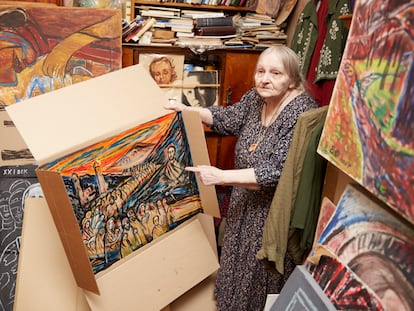Polka dots, pumpkins, luxury goods and infinite selfies: Yayoi Kusama, the artist we deserve
After decades of neglect and oblivion, the Japanese artist has become the most successful creator of our time. Underneath her work’s colorful, childlike, escapist and commercial appearance, it hides multiple layers of darkness

How does one entice people to buy a bag for €8,000 amid soaring inflation and anxiety fueled by geopolitical uncertainty? Louis Vuitton’s answer was to call on Yayoi Kusama to splash her products—skirts and coats, women’s and men’s pants, bikinis and fisherman’s hats –with her well-known polka dots. The brand then advertised that capsule collection with a series of gigantic statues in the Japanese artist’s likeness, blown up to Godzilla size, which they installed in the streets of Paris and London, in an initiative somewhere between public art and stealthy advertising.
The message was not particularly subtle: Kusama had invaded the streets and conquered the planet with her colorful blotches. And she had done it in record time: until a decade ago, few remembered the name of this 94-year-old artist, who sported garish wigs and had a fleeting moment of glory in New York in the 1950s and 1960s before falling into oblivion, returning to her native Japan, suffering from severe depression (not for the first time), attempting suicide, voluntarily committing herself to a psychiatric hospital in Tokyo and then, as an octogenarian, staging a rather improbable comeback. Kusama is the most sought-after and best-known living artist of our time, one of the few who could identify a 7-year-old child, an Andy Warhol look-alike accused of selling out to the system and commercializing her work to the hilt.
And yet, all museums want a piece of Kusama; her work is guaranteed to seduce the mass public, a surefire draw that appeals to even those who claim to abhor contemporary art. In her work, critics find the same poetry as in a lava lamp or the colored lights of a terraced garden, but there is no other living artist capable of generating the same lines (and waiting lists) to enter her exhibitions. This Tuesday, the Guggenheim in Bilbao, Spain, will be the latest museum to experience that phenomenon when it opens a retrospective entitled Yayoi Kusama: From 1945 to the Present. It will exhibit 200 works—paintings, drawings, sculptures, installations and videos of her performances—that cover her entire career, with special emphasis on what doesn’t usually meet the eye: the infinite layers of darkness that hide in a work that many see as merely childish, escapist colorism.
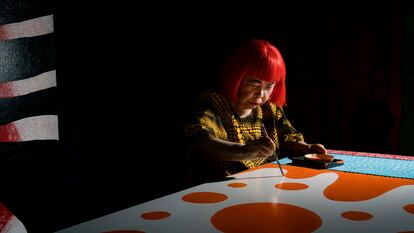
That is the paradox of Kusama’s art, which was shaped by an unhappy childhood in Matsumoto, a nondescript provincial town with an Edo-period castle. There, her wealthy family owned a small plant and seed emporium, which her nephew still runs today. That’s where her passion for vegetables comes from, even if plants were not always associated with happiness. Her works hide several traumas from her youth: the war, the terrible relationship between her parents and her first psychotic episodes in that rural environment, where she experienced various hallucinations that made her understand “the agony of the flowers,” as one of her poems puts it. Her work full of cute pumpkins and a riot of colors would ultimately speak of the terror of death, her mental health problems, her chronic frustration at a lack of recognition and of her fear of self-destruction, which she considered inevitable for a long time.
Her new status is also due to a change of context, in the face of the acceptance of women and non-Western art. She has become a trailblazer, a victim copied by the men of her time.
“In the Western world, her work has been evaluated by other criteria, but those are the issues she has fought against all her life,” says Isabella Tam, one of the curators of Hong Kong’s M+, the new museum that conceived the exhibition that is now on display in Bilbao. But has her work been moving toward greater serenity? Has her art become a commercial concession as it has recently turned into material for selfie addicts? Perhaps that’s not the only explanation. “From the 1980s onward, her work became increasingly colorful, coinciding with her voluntary admission to the hospital where she still resides. It is a transition from darkness to light that reflects a change in life philosophy. Creation has become her [source of] strength to stay alive,” says Tam.
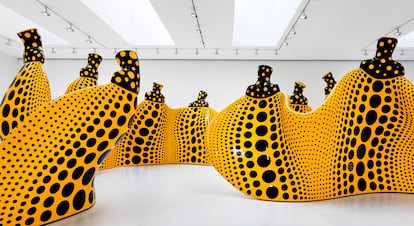
The curator notes the influence of Neolithic zoomorphism, Confucian thought and other Asian traditions on Kusama’s work: the body as an entity inseparable from the cosmos, the alternating cycles of life and death that convey the idea of resurrection. The series My Eternal Soul (2016) seems full of elements in the process of regeneration, replete with colors like intense indigo and fiery orange. That is a sign, perhaps, that Kusama has found “her own salvation,” as Tam puts it. Her new healthy lifestyle—which consists of going every day to her studio, two blocks from the hospital, a moderately friendly fortress in the Shinjuku neighborhood—has brought about a change in her work that, however much skeptics may distrust it, might not stem from opportunism alone.
Yet this infusion of new blood into her art seems inseparable from her recent popularity. “The bright tones, which seem to indicate the overcoming of trauma, her cheerful style and her message of spreading peace and love in the world through the power of art have introduced her to a new public,” says Akiko Miki, the artistic director of the Benesse Art Site, the spectacular museum complex on the Japanese island of Naoshima, which has turned Kusama’s work Pumpkin (1994) into a symbol; the piece was damaged by a typhoon last summer but reinstalled in situ months later (in reality, it is a replica of the original work, but that doesn’t really matter).
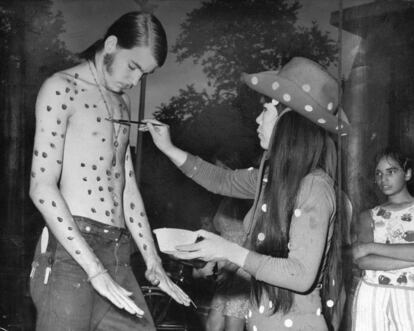
According to Miki, who was the chief curator at the Palais de Tokyo in Paris for 14 years, the artist’s current status also relates to a more favorable context. “Behind her new reputation, there’s a series of social changes, such as the acceptance of non-Western art and women artists, that matter as much as the fact that her works look good on Instagram,” she adds. Suddenly, Kusama has emerged as a trailblazer, a resister in a white and patriarchal world, a victim whom the artists of her time, like Andy Warhol and Claes Oldenburg, copied, as she relates in her memoir Infinity Net (from which an uncomfortable reference to African Americans in the original Japanese book disappeared when it was published in English).
Warhol must have copied her idea of papering Leo Castelli’s gallery with silkscreened posters of his pieces, as Kusama had done years before with her own. [It was] “a very clear appropriation or imitation of my work,” she writes. “Later, when I went to see a series of new works by Oldenburg and they turned out to be soft sculptures, his wife took me aside and said, ‘Forgive us, Yayoi!” she adds later. She discusses the textile phallus works for which she gained some renown in the United States; there, she received the support of Georgia O’Keeffe, Donald Judd and Joseph Cornell, whom she dated for a time. “Neither I nor he liked sex, so we didn’t do it,” she notes in Kusama: Infinity (2018), a documentary available on Filmin. “I started making penises in order to cure [my] feeling of disgust. Reproducing those objects over and over again was my way of overcoming fear,” she explains in her autobiography, confirming the Freudian thesis of obsessive repetition as a response to a trauma that can be located, like almost all of them, in her childhood. Her mother used to send Kusama, the youngest of four siblings, to spy on her father during his repeated extramarital affairs.
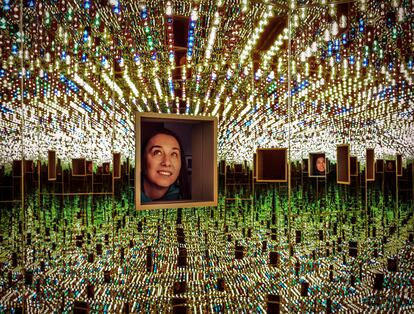
The artist has never disavowed her role as a peddler. In 1966, when it was impossible for her to exhibit at the Venice Biennale, she decided to occupy a spot outside the venue and sell an endless set of reflective spheres to passersby for two dollars apiece, as if they were “ice cream or hot dogs.” She was forced to leave the premises, as was the case in her protests at MoMA, in which she criticized the museum for exhibiting “outdated art.” Three decades later, in 1993, she returned to Venice as the official guest of the Japanese Pavilion; she was no longer persona non grata because of her rowdy profile, and a hundred of her works are now part of the collection at the New York museum that once closed its doors to her.
In the 1960s, Frank Stella haggled with her over the purchase of a work: she asked for $75, he believes that he ended up giving her only $25. Today that painting is worth $750,000. The appearance of her art has changed as well: beyond its link with abstract expressionism and minimalism, one can detect the influence of surrealism—which was very popular in postwar Japan—through the prism of hippie psychedelia. It is also influenced by the Baroque, with its play of perspectives and voluntary self-deceptions, which she reinterprets in her famous kaleidoscopic infinity rooms (although some say she copied them from the Swiss artist Christian Megert, with whom she shared an exhibition in Amsterdam three years before she created her first one in 1966). Finally, Kusama reflects the tension between the superficial harmony and strangeness underlying much of her work.
Her sudden fame owes as much to the art world as to the fashion world, as evidenced by her alliance with Louis Vuitton
Kusama’s sudden fame owes as much to the art world as to the fashion world. The first to trust her commercial potential as a luxury product was Marc Jacobs in 2012, when the designer was running Louis Vuitton. “The idea was that you weren’t just buying a bag, you were buying a work of art,” observes fashion historian Valerie Steele, the director of the Fashion Institute of Technology (FIT) in New York. “It was an absolute victory for the brand, but also for the artist, who became world-renowned. It’s only logical that Louis Vuitton has renewed that collaboration, because Kusama has become an avatar of the brand.” Since then, no self-respecting luxury brand has failed to strengthen its ties with the art world, but Steele sees more coherence in this offering than in others. Upon arriving in New York, Kusama created a line of Japanese clothing and fabrics; used mannequins, shoes and dresses in her artwork; and revealed herself to be a master of self-branding or self-promotion.
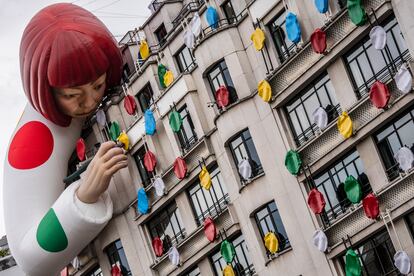
The contradiction is that work stemming from psychotic anxiety is used as an instrument of commercial hedonism. “But the same can be said of fashion, in which there is always a subtext of finitude and madness. Fashion and death are sisters,” Steele argues. “Fashion works in a series of short cycles that go on ad infinitum: fashion is dead, long live fashion.” The historian does not believe that Kusama’s frequent collaborations with luxury firms—in addition to Louis Vuitton, she has worked with Lancôme and Veuve Clicquot—will end up hurting her reputation as an artist. “There is still a stigma, although since Warhol’s time an artist’s self-promotion is already the order of the day. It is appropriate for any creator who thinks strategically.”
Who is immune from that description today? Kusama is an artist who understood that we are all entrepreneurs of ourselves. She comprehended that art was consumption and creativity was merchandise; that fashion could be the most successful art of our time; that social media offers a more desirable showcase than the best gallery; that mental health was not a joke “in a world full of nothing”; and that madness was going to become almost normative in that unhinged century. She is a woman who, against all odds, ended up winning the race in the home stretch. She may be the artist we deserve.
Sign up for our weekly newsletter to get more English-language news coverage from EL PAÍS USA Edition
Tu suscripción se está usando en otro dispositivo
¿Quieres añadir otro usuario a tu suscripción?
Si continúas leyendo en este dispositivo, no se podrá leer en el otro.
FlechaTu suscripción se está usando en otro dispositivo y solo puedes acceder a EL PAÍS desde un dispositivo a la vez.
Si quieres compartir tu cuenta, cambia tu suscripción a la modalidad Premium, así podrás añadir otro usuario. Cada uno accederá con su propia cuenta de email, lo que os permitirá personalizar vuestra experiencia en EL PAÍS.
¿Tienes una suscripción de empresa? Accede aquí para contratar más cuentas.
En el caso de no saber quién está usando tu cuenta, te recomendamos cambiar tu contraseña aquí.
Si decides continuar compartiendo tu cuenta, este mensaje se mostrará en tu dispositivo y en el de la otra persona que está usando tu cuenta de forma indefinida, afectando a tu experiencia de lectura. Puedes consultar aquí los términos y condiciones de la suscripción digital.
More information
Archived In
Últimas noticias
Maduro pleads not guilty before the federal court in New York: ‘I am still the president of Venezuela’
A new test can detect Alzheimer’s from a finger prick
UN team enters Sudanese city of El Fasher after paramilitary massacre: ‘It’s like a ghost town’
A recipe for resistance: Indigenous peoples politicize their struggles from the kitchen
Most viewed
- Gilles Lipovetsky: ‘If you want to live better and fall in love, take Prozac, don’t look to philosophy’
- Alain Aspect, Nobel laureate in physics: ‘Einstein was so smart that he would have had to recognize quantum entanglement’
- Alvin Hellerstein, a 92-year-old judge appointed by Bill Clinton, to preside over Maduro’s trial in New York
- Why oil has been at the center of Venezuela-US conflicts for decades
- Maduro’s downfall puts China’s relationship with Venezuela to the test

